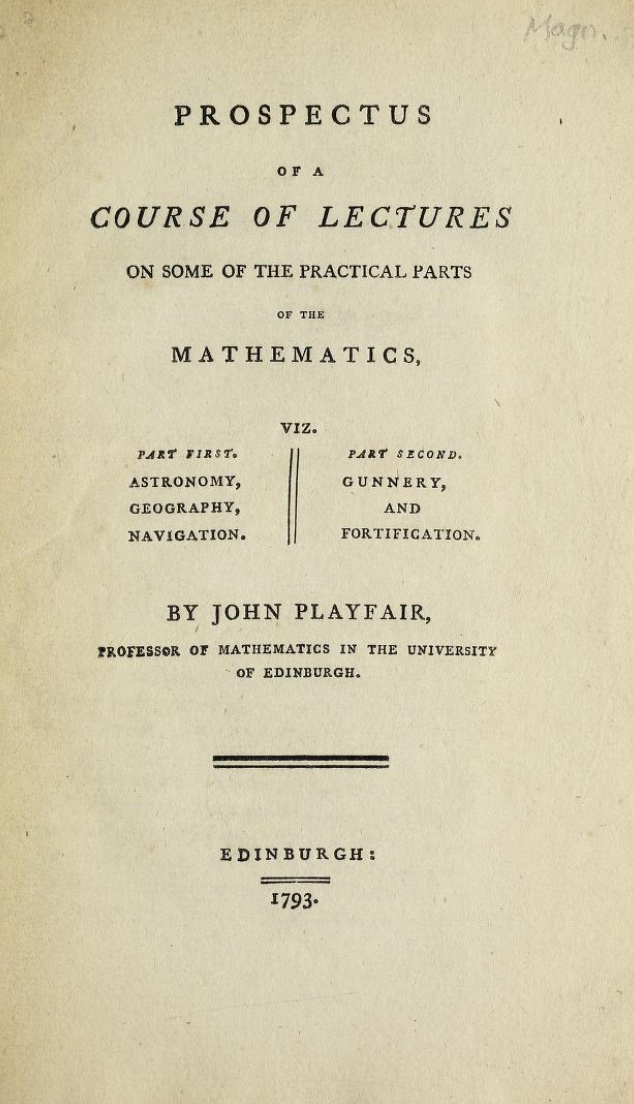- About MAA
- Membership
- MAA Publications
- Periodicals
- Blogs
- MAA Book Series
- MAA Press (an imprint of the AMS)
- MAA Notes
- MAA Reviews
- Mathematical Communication
- Information for Libraries
- Author Resources
- Advertise with MAA
- Meetings
- Competitions
- Programs
- Communities
- MAA Sections
- SIGMAA
- MAA Connect
- Students
- MAA Awards
- Awards Booklets
- Writing Awards
- Teaching Awards
- Service Awards
- Research Awards
- Lecture Awards
- Putnam Competition Individual and Team Winners
- D. E. Shaw Group AMC 8 Awards & Certificates
- Maryam Mirzakhani AMC 10 A Awards & Certificates
- Two Sigma AMC 10 B Awards & Certificates
- Jane Street AMC 12 A Awards & Certificates
- Akamai AMC 12 B Awards & Certificates
- High School Teachers
- News
You are here
Teaching Mathematics with Ephemera: Prospectus of a Course of Lectures on Some of the Practical Parts of the Mathematics
Playfair's publication record was extensive but largely expository in nature. Perhaps it is not surprising that a man who wrote out and read his classroom lectures apparently also approached his writing career as an ongoing opportunity to inform and educate. The pamphlet we will explore here fit well within these overall tendencies.

Title page of Playfair's 1793 pamphlet. Courtesy of Dibner Library, Smithsonian Institution Libraries, Washington, DC.
Prospectus of a Course of Lectures on Some of the Practical Parts of the Mathematics appeared in 1793, eight years into the professorship Playfair shared with Adam Ferguson, who remained too ill to conduct any teaching. No publisher is mentioned in the volume's slim nineteen pages, but the design of the title page is similar to designs employed by Bell & Bradfute, the increasingly prominent Edinburgh firm that in 1795 published Elements of Geometry. Although the pamphlet was professionally published, it likely was intended only for temporary use. It is not clear how many copies were made or whether they were sold or given away, but as few as eight copies remain in existence today, suggesting that few readers valued the pamphlet enough to retain it. No announcements of Prospectus's publication or evidence that Playfair actually held the course—at the University of Edinburgh, within one of the intellectual and social clubs in the city at the time, or for the general public—have been found, either. A best guess is that Playfair was gauging interest in a series of lectures or a book and either decided there was none or became involved in other projects.
The booklet is simply a detailed table of contents. As shown on the title page, Playfair announced an intention to lecture on five subjects: astronomy, geography, navigation, gunnery, and fortification. Geography was divided into astronomical geography and physical geography. While most mathematicians and educators shared a sense of how practical mathematics was defined (as the mathematical concepts utilized in the practices of people such as builders and surveyors), they had not reached consensus on the specific subjects included in practical mathematics. Those chosen by Playfair appeared in other practical mathematics textbooks, but no other textbook had exactly the same selection of subjects. Playfair's attention to physical geography was particularly unusual for a work of mathematics—indeed, the content he proposed to present was descriptive rather than mathematical—but it almost certainly arose from his interest in geology.
Within Prospectus, geography received the most importance in terms of numbers of proposed lecture topics. Astronomical geography was divided into five sections containing 40 topics, and physical geography had ten sections with 112 topics. Including the introduction, the subject had 155 topics in all. For comparison, astronomy had 14 sections with a total of 91 topics; navigation had six sections with 39 topics; gunnery included four sections with 40 topics; and fortification contained four sections with 42 topics. Thus, physical geography and astronomy were weighted almost equally. The two subjects together were to take up about half of the course, with the other half essentially balanced between the other four subjects.
The first section under the subject of astronomy illustrates what the text of the entire pamphlet looked like:
General view of the Phœnomena of the Heavens.—Apparent Motion of the fixed Stars, of the Sun, Moon, Planets, Satellites of the Planets, Comets.—To have a more accurate knowledge of these, the Doctrine of the Sphere must be explained.—Definitions.—Poles.—Primary Circles, viz. Equator, Parallels; Hour Circles or Meridians, Ecliptic, Tropics.—Arches of the Equator measured by Degrees or by Hours.—Conversion of one of these measures into the other.
Secondary Circles, Horizon, Verticals, &c.—Latitude and Longitude.—Right Ascension and Delination of the Stars.—Altitude, Azimuth of Stars.—Zenith of a Place; Latitude of a Place defined.—Elevation of the Pole (Playfair, 1793, pp. 1–2).
This analysis is conducted in more detail in (Ackerberg-Hastings, 2018). Even though the topic headings provide sparse information about how Playfair understood or taught them, they do suggest some of the priorities that guided this professor throughout his career. These will be discussed briefly on the next page, along with a few suggestions for using Prospectus—and other pieces of ephemera that are essentially outlines—in classrooms.
Amy Ackerberg-Hastings (Independent Scholar), "Teaching Mathematics with Ephemera: Prospectus of a Course of Lectures on Some of the Practical Parts of the Mathematics," Convergence (April 2019)




